How to Raise Chickens
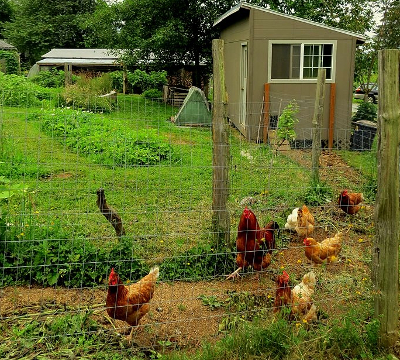
Learning how to raise chickens is a fulfilling and relatively simple way to be more self-reliant and be in closer connection to your food, whether you have a city yard or a country farm! There are tons of great resources out there for chicken rearing, but here in this article I’ll give you a run-down on the basics of chickens and how to get started with your own flock.
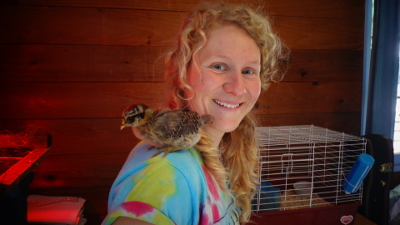
Chicken – Gallus gallus domesticus
How to Raise Chickens: History/Region of Origin
The Red Jungle Fowl, hailing from Southeast Asia, is the predecessor of modern domestic chickens. By 3200 BCE domesticated fowl were being kept in Asia, especially in India. Chickens did not arrive in Europe until 700 BCE. Theories state that the first chickens were probably kept not for meat nor eggs but for cockfighting.
How to Raise Chickens: Terminology
Hen: Female chicken
Rooster: Male chicken
Broody: When a chicken sits on her eggs to incubate them for hatching
Cloaca/vent: The single opening for reproduction and waste matter
How to Raise Chickens: Purposes
-Meat
-Eggs
-Pest control in the garden and yard
-Turning the soil in garden beds: After the harvest, let the chickens scratch and eat potential pests and give their manure to the land. Come spring, the manure will have decomposed and added nitrogen to the bed, increasing fertility.
-Compost from bedding and manure: Chicken manure is very “hot” and could burn plants if applied directly, but if composted and allowed to decompose it makes a wonderful fertilizer.
How to Raise Chickens: Considerations Before Acquiring Chickens
-Time Commitment: Most chickens need to be let out of their coop in the morning and closed in the evening to avoid predation. Are you ready to be home every morning and evening? This level of commitment can be lessened through specific types of enclosures. See “Shelter”.
-Space: Chickens do not need a ton of space, but they do need at least a run or chicken yard where they can stretch and scratch the ground and shelter. Urban chickens are completely do-able as long as you have a little corner of land!
How to Raise Chickens: Chick Purchasing Considerations
-Mail-order Chicks: When purchasing through a hatchery or farm, ensure someone will be home when the chicks arrive. With the mail-carrier still present, ensure you have the correct number of birds and that they are all alive. The mail carrier will give you a slip to send to the hatchery if not all is well. Ordering from a farm or hatchery (or driving out to one) often gives you more breed selection than the feed store.
-Feed store Chicks: Ensure chick enclosure is clean and dry with full, clean food and water containers. Consider researching where the birds are coming from and if you are okay with the ethical practices of that farm. Chicks should be active, have clear eyes and nose with no discharge, and the vent should be clean with no build up.
How to Raise Chickens: Breeds
Because there are so many breeds and crosses of chicken, I will cover the types of breeds and their general characteristics, pros, and cons. Many pros and cons may be reconsidered based on the desired purpose of the bird.
Breed can be narrowed down much more easily once the desired type is identified.
Conventional Meat Breeds
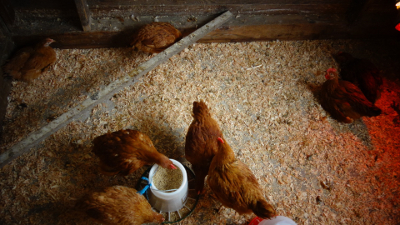 Red Rangers on Sparrow's farm. Rapidly growing due to their voracious appetites!
Red Rangers on Sparrow's farm. Rapidly growing due to their voracious appetites!Definition:
Breeds bred to grow as fast as possible with as much meat as possible.
Pros:
-Less expensive than organic free-range chicken meat from the store!
-Bred to grow fast and efficiently turn feed into meat
-Have large breasts and thighs and easy-to-pluck feathers.
-Placid demeanor, bred not to move around much and waste calories.
Cons:
-Health problems related to rapid growth can occur (sores on the breast from laying down, sores on feet from not moving around to dislodge dirt and manure.)
-Very dependent on their caretakers for feed and protection; they have very little natural instinct to stay safe or to forage.
-Usually do not have the capability of reproduction and do not have long life expectancy beyond the butcher date because their intent is for meat.
-Must be butchered all at once when they are at the appropriate age because health can decline quickly
-Must be separated from young egg layers because they grow so much faster and could harm smaller chicks
Common Meat Breeds:
-Cornish Cross (reaching tender broiler weight of 4lbs in only 7-8 weeks)
-Red Ranger Broiler (reaching 7 pounds in 80 days).
Dual-Purpose Chickens for Meat and Eggs
Definition:
Birds that are bred to lay eggs well and have enough meat to be worth eating. They “don’t lay quite as well as a laying breed and aren’t quite as fast growing as a meat breed, but they lay better than a meat breed and grow plumper faster than a laying breed” (from The Backyard Homestead –Carleen Madigan). They tend to be larger, thus more meat than egg laying breeds.
Pros:
-Well suited to a small-scale system or homestead because birds who don’t produce anymore are still suitable to eat
-Require less high-protein grain than meat birds
-Young roosters that need to be culled from the flock have more meat than slower growing egg-layers
-One system works for all the birds, you do not have to keep a meat bird system and an egg layer system
-More hardy than super quick growing meat breeds
Cons:
-Not as fast growing as meat breeds
-Don’t have as much meat as meat breeds
-Don’t lay as much as egg laying breeds
Common dual-purpose breeds:
Wyandottes, Buff Orpingtons, Barred Rocks, Black Australorps, and White Rocks
Heritage Breeds
Definition:
From The Livestock Conservancy: “Breeds that were carefully selected and bred over time to develop traits that made them well-adapted to the local environment and they thrived under farming practices and cultural conditions that are very different from those found in modern agriculture.” And thus can work well for a homestead. You can find heritage breeds for any purpose: meat, eggs, or dual-purpose
Pros:
-Preservation of genetic diversity
-More self-sufficient than many breeds, especially for free range systems
-Good foragers
-Maternal instinct (purposely bred out of many popular egg-layer breeds)
-Predator awareness
-Disease/parasite resistance
-Lower chick mortality rates
-Not prone to disability related to rapid growth
Cons:
-Slower to mature
-Potentially more difficult to come by for purchase
-Broodiness can make it more difficult to collect eggs or decrease egg production
-Predator awareness can make them more “wild” and skittish
-Less appropriate for systems with less space
A Few Heritage Breeds:
-Jersey Giant (11-13 pounds), which also produces good eggs
-The Dorking, which is kind and good with children and makes an excellent mother
-Buckeye (9lbs), which is very well adapted to cold weather and prefers to forage instead of being confined.
-Visit https://livestockconservancy.org/ for full lists of heritage breeds and their qualities
Top Egg Layers
Some of the top egg layers include the Delaware, a heritage breed producing jumbo sized brown eggs; the Rhode Island Red, which lays more brown eggs than average and is tolerant to heat and cold in addition to being adaptable to a pen or free ranging; and the Leghorn, known as the best egg layer available, producing over 300 white eggs per year.
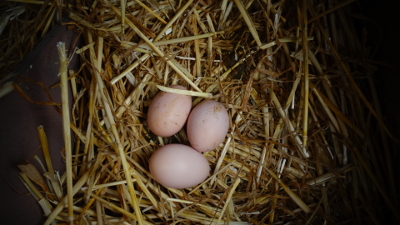 Some beautiful brown eggs from golden and black sexlink hens
Some beautiful brown eggs from golden and black sexlink hens
How to Raise Chickens: Shelter and Runs
Chicks
Location:
-Chicks that are not being raised by a mother hen usually live inside the house/barn/garage for the first 6 weeks of life, until they have their first true feathers. This helps avoid predation. (I once watched a bear eat my teenage hens that I put outside too early!)
-Chicks that are being raised by a mother hen may still need to be separated (with the mother) from the rest of the flock so they don’t get harmed by older birds
Space:
-They need 6” of space per bird until they are two weeks old, when space must be increased.
-Continue to increase space until chicks are moved outside.
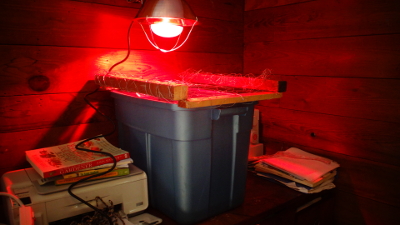 A simple brooder system for 4 chicks: A plastic tote (covered so they don't escape!) with a heat lamp above
A simple brooder system for 4 chicks: A plastic tote (covered so they don't escape!) with a heat lamp aboveBedding:
-The pen or brooder floor should have clean absorbent bedding such as wood shavings, newspapers, or straw.
-The bedding must be kept clean and dry with maintenance ranging from daily to every several days depending on the number of birds.
Heat Lamp:
-One heat lamp per 25 chicks should be used to keep them warm until they develop their feathers. Overcrowding can lead to trampling and suffocation when they all try to get under the light.
-The heat lamp should be 85-90 degrees and can be reduced 5-10 degrees by hanging it higher each week until the brooder matches the ambient temperature. Also, if placed off to one side chicks can move to self regulate their temperature.
-Make sure light is low enough to be warm but not in a position where it can catch bedding or chicks on fire!
-A red light decreases chick’s ability to see blood and keeps pecking to a minimum
-It is possible to forgo a heat lamp if an electricity-free system is desired- but chicks would have to be kept indoors near a heat source or be raised by a hen
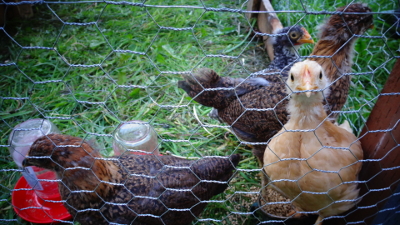 An option for teenage birds is a covered run for day-use only
An option for teenage birds is a covered run for day-use onlyAdult Chickens
Space Considerations:
-Over-crowding leads to bullying, feather-plucking, stress, even cannibalism
-There are no ‘magic numbers’ for chicken spacing, because conditions can vary greatly depending in the situation, but here are some guidelines:
- Chickens who are let out of the coop in the day: 3-4 sq. ft. coop space each
- Chickens who are restricted to a yard: 10 sq. ft. of yard space each
- 12” of roosting bar space per bird
-Temperature (cold weather causes chickens to huddle together more)
-Manure (the larger the floor space the less manure needs to be managed)
-If food and water will be outside or inside (if kept outside, less manure/crowding because birds will be out more)
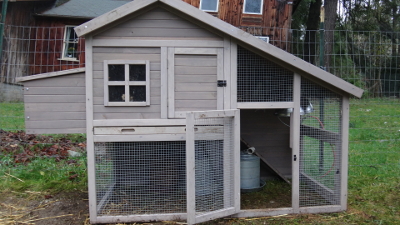 A small and easy coop option bought from the feed store
A small and easy coop option bought from the feed storeCoop Considerations:
-Adequate ventilation
-Wind and rain proof construction
-Roosting bars (roosts), suspended poles of lumber or saplings which the chickens can at least partially wrap talons around. This is where they sleep.
-Wood shavings or pellets are preferable for coop floors (sand works great for yards)
-Nesting box(es) for laying hens
- A separate area with fresh clean shavings, straw, or shredded newspaper bedding in which hens lay eggs. Having access to the nesting boxes from outside the coop can be useful if the coop is small.
- On 12" cube box or 18" diameter basket per 4 hens works well. If space is at a premium, consider a community nesting box - a 2' x 3' box is adequate for 24 hens.
-Predator safety
- Know the predators in your area.
- Raccoon-proof doors and latches; bear-resistant material; rat, weasel, and opossum proof hardware-cloth base dug into the ground; coyote and fox proof door and walls; raptor proof ventilation
-Lighting
- 16 hours of daylight is ideal for maximum egg production
- Hens lay much less in the winter without a light. Some people choose to give the birds a break, others prefer a potentially shorter but more constant egg laying career so they are not feeding non-producing animals
- Use a red heat lamp in a safe location with a timer set to turn on early enough in the morning to equal 16 hours of total daylight
- Set the light for the morning because a light switching off to total darkness at night is disorienting for chickens
-Bedding
- Do NOT use cedar shavings, they can be toxic to animals
- Straw is affordable but the hollow straws can harbor mites
- White pine shavings are preferable
- Depending on size of coop, bedding must be changed often enough to keep birds healthy.
Be More Prepared For Your Next Outdoor Adventure!

Don't leave without knowing these six essential survival skills. Our free survival mini guide reveals the strategies of:
- Shelter & fire to prevent the number one cause of death
- Obtaining clean water to avoid life-threatening dehydration
- Common wild survival foods and other critical skills!

Chicken Tractors:
-Movable coops with attached yards allow chickens to graze on fresh grass and provide manure across a big swath of land
-Human-power required to move small chicken tractor or vehicle/horse power is required to move large tractors
-Some people use chicken tractors in the spring-summer-fall and more hardy quarters in the winter
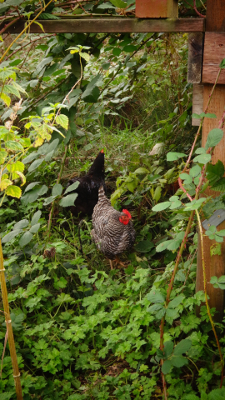 A barred rock hen and sexlink hen in a fenced yard
A barred rock hen and sexlink hen in a fenced yardChicken Runs and Yards:
-The safest area for chickens to range is a yard/run fully covered with chicken wire to protect from aerial predators
-If the yard is completely secure, you do not have to close the chickens into the coop at night
-If there is any way for predators to enter the yard, strongly consider closing the door to the roost when the chickens go to bed at dusk, and let them back out in the morning. Light sensitive monitors or timers can be used to do this automatically without you
 A barred owl looking for a tasty chicken dinner
A barred owl looking for a tasty chicken dinner
How to Raise Chickens: Feed
Formulated feed can be purchased and contains carbohydrates, fats, vitamins, minerals, and protein. This chart can give you an idea of the amount that is needed in raising a chicken on store bought feed.
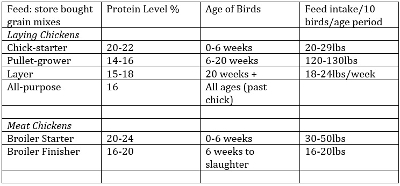
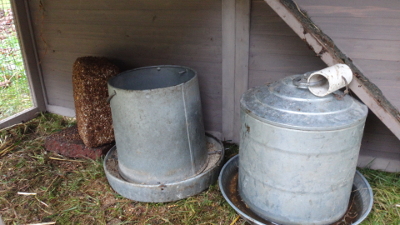 Galvanized metal feeder and water containers
Galvanized metal feeder and water containersAdditional Feed Possibilities
-Table scraps
- Great way to cut down on cost.
- Feed chickens as much as they will eat in 15-20 minutes.
- Feed non-spoiled, non-moldy scraps (including meat) of most foods.
- Avocados can be toxic to chickens in significant quantities. Do not feed peels of banana or onions nor raw potatoes or their skins.
- Cook or grate very hard foods like carrots
-Fermented grain
- The fermentation process makes grain more nutritious, and chickens eat less of it so it stretches your dollar!
- Put grain in a bucket and cover with water. Allow to sit for 2-3 days, then feed 1/3 cup per chicken per day in a pan.
- In the cold months you can make larger portions. In the warm months it will mold if it sits around too long.
-Spent brewer’s grain
- Obtain at a beer brewery. Feed about 1 cup per 5 chickens to supplement other feed. Too much could impact egg production
- Contains between 15-30% protein depending on grains used
- Freezes well and can even be given in frozen blocks for chickens to peck at.
-Greens
- Clover, alfalfa, dandelions, nettle, chickweed, lettuces, kale, etc...
-Bugs
- Worms, flies, beetles, earwigs, mealworms, etc...
Mineral Needs
-If chickens are allowed to forage or free range, they should not need any supplemental vitamins or minerals except calcium, which all layers need for healthy egg production.
-Calcium can be provided with oyster shell or the chicken’s own eggs shells, so long as they are ground/crushed up to minimize cannibalizing their own eggs.
-Grit, little pebbles, tiny rocks, or sand is needed for chickens to grind down their food in their gizzards as they don't have teeth.
Water
-Provide fresh, clean water daily.
How to Raise Chickens: Health
-Most health problems can be avoided by ensuring chickens have an adequate diet, enough space, and as stress-free of a life as possible (eliminating predators, including barking dogs).
-All new additions to the flock should be quarantined for a minimum of 2 weeks before adding them to the flock. (30-60 days is more ideal, especially for a larger farm with higher consequences.)
-At first signs of illness, consider isolating the sick bird until you can make sure the problem will not spread.
Signs of Disease:
-Abnormal feces: Milky clear, bloody, diarrhea
-Messy vent
-Messy, unkempt feathers
-Discharge from mouth or nostrils
-Blisters or wounds
-Abnormal aggression (not previously witnessed)
-Lack of interest in eating or drinking
Wound Care:
-Chickens will peck at the sight of blood and can severely harm each other. If a chicken is bleeding remove them from the flock! Once the blood has dried they can be returned.
-Chickens can be extremely hardy and resilient. With proper care they can heal from impressive wounds.
For bloody wounds:
- Irrigate with an irrigation syringe full of water or a diluted iodine solution (the color of weak tea).
- If you feel you must apply a salve or ointment to promote healing, please make sure it is safe to ingest, as chickens will ingest it while they preen to clean themselves. Salves such as Animal Scents, or BluKote help clean and promote healing.
- Clean each day.
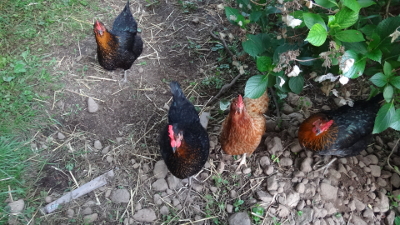 Several of Sparrow's hens looking for tasty food scraps
Several of Sparrow's hens looking for tasty food scrapsI hope you found these considerations for how to raise chickens helpful and that they assist you in maintaining a healthy, happy and productive flock. Happy chicken raising!
By the way, a big part of why we love homesteading & permaculture skills so much is because they are a natural extension of learning about wilderness survival (both fields are all about self-sufficiency and working with nature to satisfy needs). An understanding of survival not only helps you become a better permaculturist, it empowers you with life-saving outdoor skills to keep you safe when out in nature. Right now you can get a free copy of our mini survival guide here, where you'll discover six key strategies for outdoor emergencies, plus often-overlooked survival tips.
Additional Resources on How to Raise Chickens:
The Complete Beginner’s Guide to Raising Small Animals – Carlotta Cooper
The Complete Encyclopedia of Chickens – Esther Verhoef and Aad Rijs
The Joy of Keeping Chickens – Jennifer Megyesi
Storey’s Guide to Raising Chickens – Gail Damerow
The Backyard Homestead –Carleen Madigan
http://thebackyardchickenfarmer.com/
https://livestockconservancy.org/
Related Courses:
Learn about Permaculture Courses at Alderleaf

About the Author: Leah Houghton is an experienced outdoor educator. She wrote articles while teaching at Alderleaf. Learn more about Leah Houghton.
Return from How to Raise Chickens back to Permaculture Articles
Is The Essential Wilderness Survival Skills Course Right for You? Take the "Online Survival Training Readiness" Quiz
See for yourself if this eye-opening course is a good fit for you. It takes just a few minutes! Get your Survival Training Readiness Score Now!

Grow Your Outdoor Skills! Get monthly updates on new wilderness skills, upcoming courses, and special opportunities. Join the free Alderleaf eNews and as a welcome gift you'll get a copy of our Mini Survival Guide.

 The Six Keys to Survival: Get a free copy of our survival mini-guide and monthly tips!
The Six Keys to Survival: Get a free copy of our survival mini-guide and monthly tips!
Learn more